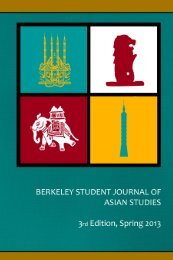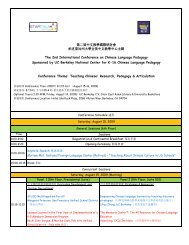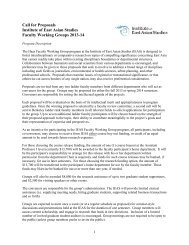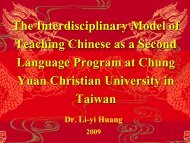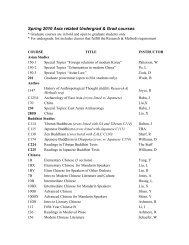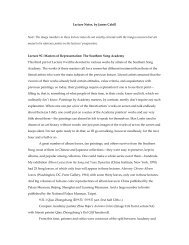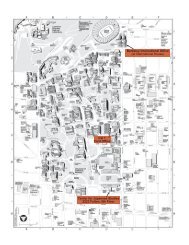short essay - Institute of East Asian Studies, UC Berkeley
short essay - Institute of East Asian Studies, UC Berkeley
short essay - Institute of East Asian Studies, UC Berkeley
- No tags were found...
You also want an ePaper? Increase the reach of your titles
YUMPU automatically turns print PDFs into web optimized ePapers that Google loves.
the protestant imagination (barshay) 1The Protestant Imagination: A Note on Maruyama Masao, Robert Bellah,and the Study <strong>of</strong> Japanese Thoughtoriginally presented at the panel on “Maruyama Masao, Political Philosopher”International Political Science Association, Fukuoka, Japan, July 2006Andrew E. BarshayHistory Department<strong>UC</strong> <strong>Berkeley</strong>In midsummer <strong>of</strong> 1980, the historian Ienaga Saburō sent Maruyama Masao a copy <strong>of</strong> hisnew book, Zoku Shinran o kataru (Speaking <strong>of</strong> Shinran, Continued), and Maruyamaresponded with a brief letter <strong>of</strong> thanks. In part it reads: “My family on my father’s sidewere Pure Land (Jōdoshū) Buddhists, but my father himself was a thoroughly antireligious,empirically-minded journalist, while my mother and her elder brother (InoueKiroku, a member <strong>of</strong> the Seikyōsha) were fervent True Pure Land (Shinshū) believers.Until middle school, in the mornings before breakfast I used to put my hands togetherand pray in front <strong>of</strong> our household Buddhist altar, but by the time I was an upperclassman I had thought to myself, ‘I’m no believer, and it doesn’t make any sense to recitethe nenbutsu.’ But if I were asked who among the figures in Japanese intellectual historyhas had the strongest influence on me, I would answer without hesitation: Shinran. Onthe other hand, looking through your book…and seeing the passages where you werecritical <strong>of</strong> Christianity, I thought that your way <strong>of</strong> thinking and mine are different. Yourposition is extremely close to Buddhism, yet you do not become a believer. In my case,my relation to Christianity is rather similar…” 1For modern Japanese thinkers who have reached a certain maturity, or perhaps a crisis,Shinran (1173-1262) has exerted an almost magnetic attraction. Kurata Hyakuzō’s play,Shukke to sono deshi (The Priest and His Disciples, 1917), written out <strong>of</strong> its young author’sown spiritual torment, created a contemporary Shinran (identified largely with theTannishō), much as Karl Barth had done for St. Paul and his Epistle to the Romans (1918).Nishida Kitarō, Tanabe Hajime, Miki Kiyoshi, Hattori Shisō, among others, wrote onShinran. Why? What does Shinran stand for? It could be the spiritual integrity, theexistential authenticity <strong>of</strong> the individual thinker as reflected, however dimly or brightly, inthe mirror <strong>of</strong> Shinran’s own faith. It could be the recognition <strong>of</strong> radical evil in the souland the world, and transcendence (through total dependence on Other Power) in facingit. It could be the classic religious paradox <strong>of</strong> “irrational” faith confounding humanwisdom in the ineffable cry <strong>of</strong> praise to Amitabha Buddha and his Original Vow to showcompassion to all sentient beings. In Ienaga’s case, it was Shinran’s embodiment <strong>of</strong> whathe called the “logic <strong>of</strong> negation” in Kamakura Buddhism, one <strong>of</strong> the very few moments <strong>of</strong>“breakthrough” in Japan’s intellectual and spiritual heritage when “values transcending1 Maruyama to Ienaga, Maruyama Masao shokan shū (Misuzu Shobō , 2004), 3: 18.
the protestant imagination (barshay) 2everyday reality became the nucleus <strong>of</strong> Japanese thought.” 2 At such a moment, culture,society and politics lie subject to judgments whose authority claims an absolutely Other,transcendent referent. But since those judgments must be acted on in the given socialworld, absolute Otherness must, paradoxically, subsist on fallible human instruments andmaterials. Otherness must become part <strong>of</strong> history, one self-consciously but imperfectlymade in the image <strong>of</strong> that Other.Now Maruyama wrote virtually nothing about Shinran—only a few scattered referencesin his published works, and an overview <strong>of</strong> Shinran’s thought in his 1964 universitylectures on Japanese political thought. 3 But along with this snippet <strong>of</strong> testimony, we mayfind another clue to what the attraction was. It comes from Jikonai taiwa (InteriorDialogues), the notebooks collated and published after his death, in a fragment (datedsometime after 1961) on Dostoevsky: “I first read Dostoevsky’s The Possessed just after Ihad graduated from the university. Once having read it, I could never again return to theself I had been before reading it. I was raped [gōkan sareta] by Dostoevsky. To this day Ihave not recovered from the wounds this caused in me. Again and again it has worked asa brake on my innate tendency toward an emotional radicalism. Not just that; it forcedme to become aware <strong>of</strong> what radical thought really was.” 4Maruyama’s comments on Shinran and Dostoevsky suggest that he saw the world as adarker and more desperate place than we are used to associating with him and histhought. 5 The problem <strong>of</strong> radical evil, Maruyama seems to say, is both personal andpolitical, and must be confronted in both dimensions. It is a kind <strong>of</strong> hidden, inner liningto his far better known position on personal autonomy or “subjecthood” (shutaisei), whichhe regarded as the capacity <strong>of</strong> socialized individuals to make intellectual and ethicaljudgments; to act on their surroundings, their world, and to take responsibility as they didso. “The human being,” Maruyama once observed, “is an animal endowed with alimitless capacity for self-deception.” 6 In the world <strong>of</strong> modern politics, the opportunitiesfor self-deception are legion and the consequences can be devastating. On the one hand,the Big Lie becomes the Only Truth; party loyalty (or discipline) justifies betrayal <strong>of</strong> selfand others; physical and psychological violence become loving or stern “correction”; warbecomes peace. On the other, “they” control politics (and economics); “I” don’t careabout it. As long as “I” am taken care <strong>of</strong>, and can buy what “I” want (things, feelings,ideas, influence), do “I” need to concern myself with what “they” do? Or we have the2 “…became the nucleus”: Katō Shūichi, History <strong>of</strong> Japanese Literature: The First Thousand Years(Kodansha International, 2002), p. 215ff. Emphasis in original. Ienaga’s key work in thisconnection is Nihon shisōshi ni okeru hitei no ronri no hattatsu (1940).3 For the lecture see Maruyama Masao kōgiroku, vol. 4, Nihon seiji shisōshi 1964 (Tokyo DaigakuShuppankai, 2004), pp. 234-52.4 Maruyama Masao, Jikonai taiwa (Misuzu Shobō, 1998), p. 51. “Radicalism” is Maruyama’skatakana gloss for sayokushugi.5 I thank Hiraishi Naoaki for first emphasizing to me Maruyama’s deep sense <strong>of</strong> “sin.” Personalcommunication, July 2004.6 Maruyama Masao, “Shisō shi no hōhō o mosaku shite—Hitotsu no kaisō,” Nagoya Daigaku hōseironshū (1977), p. 2.
the protestant imagination (barshay) 3“let the market decide” fiction, in which there is, as Margaret Thatcher remarked, “nosuch thing as society.” 7In the context <strong>of</strong> Japanese religious thought and its history, the perception <strong>of</strong> an innatelywounded, defective, depraved or evil human nature has been most closely associated withthe Salvationist “reform” Buddhism <strong>of</strong> the Kamakura era, and, <strong>of</strong> course, with the morerecent import <strong>of</strong> Christianity. As we know, the historical—political—consequences forJapan <strong>of</strong> these Salvationist moments have been complex, and have captured theimaginations and critical energies <strong>of</strong> philosophers, thinkers, and historians to this day.And it is that complex <strong>of</strong> consequences that sets the framework for my discussion here,which focuses on the problem <strong>of</strong> social self-transformation in Maruyama’s thought. First,I will sketch briefly what I call Maruyama’s “protestant imagination” and try to accountfor one crucial line in its development; in the second section <strong>of</strong> the paper I will compare itwith another such imagination—that <strong>of</strong> the sociologist <strong>of</strong> religion Robert N. Bellah, withwhom Maruyama’s intellectual life was for some time closely bound.As Maruyama observed, neither he nor Ienaga had made a conversion to the respective“breakthrough” faiths whose influence and significance they both acknowledged. Theyremained by choice at the limen <strong>of</strong> organized religious life, <strong>of</strong> the community <strong>of</strong> fellowbelievers. Non-conversion too has a history. Max Weber had famously pr<strong>of</strong>essed himselfto be “tone-deaf” to religious feeling, even as he probed the literally world-alteringcharacter <strong>of</strong> the human type engendered by the Protestant Reformation in a vastcomparative enterprise. An almost inverse case would seem to be that <strong>of</strong> Simone Weil,the Jewish-born French philosopher. A radical Platonist, mystic, and political activist onthe left, Weil’s entire spirituality was Catholic. But for well-elaborated reasons sherefused baptism, for though “by right” the church was universal, “in fact” it was not. Tothat extent, the church’s worldly limitations left outside it too much that she loved. Therewere solidarities and affinities that Weil refused to renounce, precisely on account <strong>of</strong> herfaith. 87 Thatcher’s pronouncement, her most famous, dates from a 1987 interview with Woman’s Ownthat was later amplified in the Sunday Times. See the original interview transcript on the website<strong>of</strong> the Margaret Thatcher Foundation (www.margaretthatcher.org/speeches/). The relevantpassages read: “I think we have gone through a period when too many children and people havebeen given to understand ‘I have a problem, it is the Government's job to cope with it!’ or ‘I havea problem, I will go and get a grant to cope with it!’ ‘I am homeless, the Government must houseme!’ and so they are casting their problems on society and who is society? There is no such thing!There are individual men and women and there are families and no government can do anythingexcept through people and people look to themselves first…There is no such thing as society.There is living tapestry <strong>of</strong> men and women and people and the beauty <strong>of</strong> that tapestry and thequality <strong>of</strong> our lives will depend upon how much each <strong>of</strong> us is prepared to take responsibility forourselves and each <strong>of</strong> us prepared to turn round and help by our own efforts those who areunfortunate.”8 On Weil see her Waiting on God (Harper Torchbooks ed., 1973), pp. 61-83, 85-87, 94-98; alsoJean-Marie Perrin and Gustave Thibon, Simone Weil as We Knew Her (1953; Routledge, 2003), pp.146-60; Richard Rees, Simone Weil: A Sketch for a Portrait (Oxford, 1966), pp. 46-47. Note also hercomment, in Gravity and Grace: “To contemplate the social scene is as effective a purification as to
the protestant imagination (barshay) 4Leaving aside Ienaga now, why did Maruyama remain in his liminal relation toChristianity? If he had (lastingly) converted, with what community <strong>of</strong> believers would hehave chosen to affiliate? What were the consequences <strong>of</strong> his non-conversion? The firstquestion is (for me) not idle, but it is unanswerable. Concerning the second and third, it ispossible to speculate with a decent measure <strong>of</strong> assurance. As Maruyama’s biographyshows, he had spent many <strong>of</strong> his intellectually formative years at the fringes <strong>of</strong> UchimuraKanzō’s Mukyōkai, the anti-institutionalist Non-Church wing <strong>of</strong> Japanese Protestantism.Chiefly this contact was through Nanbara Shigeru, with whom Maruyama studied at theLaw Faculty <strong>of</strong> Tokyo Imperial University, and whom he regarded for the rest <strong>of</strong> his lifeas one <strong>of</strong> his two real teachers. With Nanbara, Maruyama read Hegel, and (despite hismentor’s criticisms <strong>of</strong> Hegel) was himself “Hegelianized.” It was Nanbara, also, whopressed Maruyama not to follow him into the study <strong>of</strong> Western political thought, but toconfront Japanese political tradition on its own grounds, with and through its own texts,albeit via a historical method that was grafted onto those texts from outside.Like his near contemporary and university colleague Yanaihara Tadao, Nanbara was adirect disciple <strong>of</strong> Uchimura, but unlike Yanaihara, Nanbara neither evangelized activelynor established a home-church with himself as spiritual father; nor did Nanbara followUchimura and Yanaihara into pacifism. On the other hand, Nanbara does seem to haveabsorbed something <strong>of</strong> the later Uchimura’s eschatology, regarding his bureaucraticduties in essentially religious terms; he was to “remain in place,” performing his earthlytasks so as to hand over to the Lord on his return a piece <strong>of</strong> the world in good order. ForNanbara, religious faith was transmuted into bureaucratic expertise. Perhaps if wesubstitute “scholarly” for “bureaucratic,” we may have an inkling <strong>of</strong> Maruyama’s ownattitude toward his choice <strong>of</strong> a way <strong>of</strong> life.The Mukyōkai milieu in its various strands did present a coherent face to the Japaneseintellectual world that Maruyama had entered: it exalted the individual conscience, thecapacity to interpret the divine word without priestly mediation, and the physicalinviolability <strong>of</strong> the person. It had a providential concept <strong>of</strong> nationality that rejected bothtraditional and neo-traditional patriarchalism, and the quest for validation and legitimacythrough dependence on foreign institutional authority. 9 Uchimura’s Mukyōkai vision, in<strong>short</strong>, was <strong>of</strong> a Japan that had been elected as the site for the completion <strong>of</strong> thewithdraw from the world, and that is why I have not been wrong in mixing for so long a time inpolitics” (1952; Routledge ed., 1995), pp. xvi, 146.9 Despite their rejection <strong>of</strong> emperor-worship as idolatrous, Mukyōkai fugures were not hostile tothe monarchy. Uchimura was certainly not. One <strong>of</strong> the sharp dividing lines between Maruyamaand Nanbara (along with Yanaihara) was the latter’s intense veneration <strong>of</strong> the emperor. This wasa highly idealized, demythologized and humanized emperor, but nonetheless unacceptable toMaruyama under any circumstances. It is to be noted, on the other hand, that Nanbara did notwait until August 1945 to begin this demythologizing. While acknowledging the traditionalidentification <strong>of</strong> the emperor as arahitogami, Nanbara stressed that the “organic unity” between theJapanese emperor and his people stemmed from the “realistic” relation between them, one basedon fear and affection directed toward the sovereign as the nucleus <strong>of</strong> a familial nationalcommunity with natural, historical origins. See Nanbara Shigeru, “Gendai no seiji risō to Nihonseishin” (1938) in Nanbara Shigeru chosakushū (Iwanami Shoten, 1974), 3: 111-13.
the protestant imagination (barshay) 5Reformation, in which the “church” lived through households and independent spiritualgroupings that suffused and energized the very society.Whatever his other, and vital, influences—Hegel, Kant, Weber, Fukuzawa—I want tosuggest that in the absence <strong>of</strong> this Mukyōkai “impulse,” Maruyama’s conceptions <strong>of</strong>selfhood, politics, Japanese democracy, indeed <strong>of</strong> Japan itself, could not have taken theforms they assumed. On the other hand, if he had actually converted to Christianity, wouldhe have been able to sustain the degree <strong>of</strong> critical identification—which was sometimesexcruciating for him—that allowed him to immerse himself so deeply in the multipleworlds <strong>of</strong> the Japanese intellectual tradition? My sense is that he could not have done so.Maruyama, that is, became a protestant without becoming a Christian. His imagination,not his faith, was protestant. If Shinran symbolized the confounding <strong>of</strong> human depravitythrough the grace <strong>of</strong> Other Power, and Dostoevsky the capacity <strong>of</strong> self-deceiving totalcommitment to generate terror, Maruyama’s protestant imagination <strong>of</strong>fered a means <strong>of</strong>secular reformation. It led him to conceive a modern (Japanese) personality type capable<strong>of</strong> acknowledging the “demonic” psychological drives that propelled power-seekersthrough the world <strong>of</strong> politics, the massive force <strong>of</strong> “tradition” and social inertia, and thenewer, nearly irresistible pressure to conform generated by mass media. This was apersonality that, having said, “I judge you to be wanting,” would then seek to acteffectually (in a solidarity <strong>of</strong> reason) to counteract those forces and to change that world.The inspiration for this “type” is clear. In his 1948 <strong>essay</strong>, “Ningen to seiji” (Man andPolitics), Maruyama wrote: “Perhaps the one capable <strong>of</strong> the most thoroughgoing protestfrom the standpoint <strong>of</strong> personal interiority [jinkakuteki naimensei] would be a radicalProtestant, such as an adherent <strong>of</strong> the Non-Church.” The “protestant imagination” inMaruyama was repelled by authoritarianism, especially when cloaked in the colonizedcharisma <strong>of</strong> the emperor, but also by corrupted “orthodoxies” based on “total” systems <strong>of</strong>thought, such as Marxism. The “protestant” was a man or woman who has “the sense <strong>of</strong>being bound by an invisible authority—whether it is God or Reason or an ‘-ism’ [shugi]doesn’t matter”—that goes beyond the “world that appears before our eyes as anexperiential reality.” The particularly modern danger <strong>of</strong> losing sight <strong>of</strong> the invisible, so tospeak, is that <strong>of</strong> “being dragged along by visible authority—political powers, publicopinion, reputation.” 10 These were the forces that all too <strong>of</strong>ten subverted, bleached out,and denatured the “logic <strong>of</strong> negation” that lay at the core <strong>of</strong> the protestant imagination.With these forces we are all familiar; we live with their effects every day.I turn now to the comparison <strong>of</strong> Maruyama and Bellah. 11 Despite major differences intheir national, religious and generational backgrounds, the intellectual affinities between10 Maruyama Masao, “Ningen to seiji” (1948), in Maruyama Masao shū (Iwanami Shoten, 1995), 3:220; on “invisible authority”: statement by Maruyama in round-table, “Maruyama Masao shi okakonde—Chosha to kataru” (Tenbō, July 1966), in Maruyama Masao zadan (Iwanami Shoten,1998), 5: 315. In composing this section I have benefited greatly from the suggestive and broadrangingnew work by Karube Tadashi, Maruyama Masao—Riberarisuto no shōzō (Iwanami Shinsho,2006).11 For a recent <strong>essay</strong> comparing Bellah and Maruyama (focusing on their conceptions <strong>of</strong>modernization), see Yamamoto Tomohiro, “Robāto N. Berā no Nihon kindaika ron—Maruyama
the protestant imagination (barshay) 6Maruyama and Bellah are deep and long running, and constellate around the notion <strong>of</strong>reformation. In it, explicitly or implicitly, both sought a viable modus and ideology <strong>of</strong>modernization. Rather than the decadence <strong>of</strong> tradition requiring a violent, revolutionary,once-and-for-all inversion by an absolutely antagonistic “other,” they both envisioned amodern social order capable <strong>of</strong> radical self-transformation and constant renewal throughthe critical reappropriation <strong>of</strong> its own original form and consciousness—its religiopoliticalarchetypes. In this sense, I will suggest, both displayed a “protestant”imagination that—in mutually differing ways—ended as an unfulfillable promise.Robert Bellah, <strong>of</strong> course, is the author <strong>of</strong> Tokugawa Religion (1957), a landmark <strong>of</strong> Japanesestudies. It remains in active service in graduate training not only for its historical findingsbut just as much as an introduction to an important lineage in American sociologicalthought. Depending on whether one reads the original or 1985 edition, this was a study<strong>of</strong> either “the values <strong>of</strong> preindustrial Japan” or “the cultural roots <strong>of</strong> modern Japan.”Bellah was a student <strong>of</strong> Talcott Parsons; and Parsons, as Bellah puts it, “had created anoptimistic Weber.” 12 Synthesizing their approaches, Tokugawa Religion developed out <strong>of</strong>the multifarious strands <strong>of</strong> Japanese religious traditions an ideal type <strong>of</strong> attitudes andaction that served as a “functional equivalent” <strong>of</strong> the inner-worldly asceticism <strong>of</strong> theProtestant ethic in its unintentional but decisively significant (causal?) relation to the spirit<strong>of</strong> capitalism. Did this “Tokugawa religion,” Bellah asked, promote “rationalization” inthe social system, and if so, in which <strong>of</strong> its domains? And could this “rationalization” beshown to have been extended, institutionalized, formalized in the modern era, thusestablishing a direct, positive linkage between traditional and modern Japan? In <strong>short</strong>,did Tokugawa religion provide the cultural roots <strong>of</strong> modern Japan? That was the project:and Bellah found what he was looking for, if not entirely where he was expecting to findit. To be sure, he located an impetus toward the “rationalization <strong>of</strong> means” in theeconomy, and he identified religious motives, movements, and thinkers—notably IshidaBaigan’s Shingaku (Learning <strong>of</strong> the Mind/Heart) that gave it cultural and moral sanction.But Bellah’s key finding was that economic rationalization played the role <strong>of</strong> handmaiden(this is my term) to the more consequential process <strong>of</strong> rationalization that he saw at workin the polity. It was not the directly “universalistic” values <strong>of</strong> the economy thatdominated the process <strong>of</strong> rationalization resulting in Japan’s industrialization, but, withtheir support, the “generalized particularism” <strong>of</strong> the polity, whose values penetrated theeconomy. Traditional status-demarcated loyalties to the lord, domain and ultimately theemperor were sublated, their social base vastly expanded, and their function “as-ifuniversal.”The “particularistic-performance values” <strong>of</strong> the polity, <strong>of</strong> the “central valuesystem,” were “pushed” by the 1930s, Bellah notes, to an “extreme and pathologicallimit,” and even at the time <strong>of</strong> writing were undercutting “the ‘democratic’ ideology <strong>of</strong>the postwar period.” 13 But on the whole, no shadow <strong>of</strong> historical tragedy hangs over thebook.Masao ni yoru hihan o chūshin ni,” Shakaigaku kenkyū, no. 76 (November 2004): 161-187. I amgrateful to Shimizu Yasuhisa for bringing this article to my attention.12 Robert N. Bellah, Tokugawa Religion (Beacon Press, 1985), p. xii.13 Bellah, Tokugawa Religion, pp. 105-06.
the protestant imagination (barshay) 7As Bellah notes in his conclusion, Tokugawa Religion does not really treat the post-1868period. That was not merely a matter <strong>of</strong> his having chosen one research design amongthe many conceivable. As an ex-Communist who had failed to cooperate in namingnames, Bellah was denied a passport to carry out doctoral work in Japan, and wastherefore compelled to pursue a historical inquiry rather than fieldwork. 14 We maywonder how different his academic life and the field <strong>of</strong> Japanese studies would have beenhad the era’s politics been otherwise. But one fateful consequence <strong>of</strong> Bellah’s havingpursued the Tokugawa “roots” question was his intellectual encounter with MaruyamaMasao. Maruyama reviewed Tokugawa Religion in the Kokka Gakkai zasshi at unusuallength, not just recapitulating its arguments but analyzing the Parsonian system <strong>of</strong> patternvariables, rehearsing the exposition chapter by chapter, and then—in his final pages—boring in on what he termed its “great defect” and “grave misuse <strong>of</strong> Max Weber’s logic.”Maruyama was roused and excited by Bellah’s work, and enormously respectful <strong>of</strong> it. Hisown Nihon seiji shisōshi kenkyū (translated as <strong>Studies</strong> in the Intellectual History <strong>of</strong> Tokugawa Japan,1979) had appeared in book form only in 1952, and it seemed that the two authors weremoving along convergent paths. Both had identified crucial impulses, in Japanesereligious and political thought respectively, that pointed toward a process <strong>of</strong> indigenousmodernization in Japan. While Maruyama’s discovery <strong>of</strong> a “discoverer <strong>of</strong> politics” inOgyū Sorai (1666-1728) ended in a thwarted breakthrough to modernity, Bellah seemedmore sanguine. Maruyama simply could not accept Bellah’s argument for the “internalrelationship between the rationalization <strong>of</strong> religion and the rationalization <strong>of</strong> economyand polity” in Tokugawa Japan and its positive impact on modernization. ForMaruyama, the “simple” (simplified) emperor worship promoted by the “nationallearning” or kokugaku movement was far from religiously, let alone politically, rational,because it was accompanied by the “penetration <strong>of</strong> the principle <strong>of</strong> piety into all socialrelationships through the incessant reproduction <strong>of</strong> the output <strong>of</strong> traditionalism from theintegrative system.” “Why in the case <strong>of</strong> Japan,” Maruyama asks, “was not the process <strong>of</strong>the unification <strong>of</strong> the local divinities and folk religions ever a uni-directional course <strong>of</strong>liberation from magic?” The problem to be pursued, Maruyama argued, was “how themagical character at the top and bottom levels <strong>of</strong> the society internally characterized theJapanese rationalization and modernization and pushed it forward.” “Pseudouniversalism,”Maruyama urged (Bellah did not use this term), had lowered “theuniversalistic standard” by sanctifying hierarchy rather than equality under newconditions. The undeniable presence <strong>of</strong> rationalizing elements in society and in the“structure <strong>of</strong> personality” merely begged the question as to whether they were being“applied to life methodisch-systematisch”: but only if they were could the “ascetic ethic standin tension with this world” and have the “dynamism to change it.” What Bellah hadactually explained was “the tradition <strong>of</strong> the coexistence and the parallel use <strong>of</strong> loyalty andegoism, frugality and indulgence, serious endeavor and resignation.” 15 Japan, to put itbluntly, had not experienced a modern Reformation, and could not have done so. Its14 See Robert N. Bellah, “To the Editor,” New York Review <strong>of</strong> Books (February 10, 2005); on thepassport issue: Bellah, personal communication, June 2006.15 Maruyama Masao, review <strong>of</strong> Tokugawa Religion (1958), as translated by Arima Tatsuo (MS), pp.37, 40, 41, 42-43, 44, 46. I am grateful to Robert Bellah for making this text available to me. Cf.Maruyama’s original in Maruyama Masao shū, 7: 281, 283, 284, 285, 287-88.
the protestant imagination (barshay) 8modernization, and therefore its modernity, was tragically incomplete, and as such,deformed.Bellah’s response to Maruyama’s review was open-handed and accepting, to a point. In away, he never stopped responding to it. By the early 1960s he had been able to travel toJapan and make up for lost time in examining contemporary Japanese religion andintellectual life. I would say, in fact, that the latter was his real concern, to judge by theseries <strong>of</strong> finely wrought and ambitious <strong>essay</strong>s on Ienaga Saburō, Watsuji Tetsurō, and thegeneral question <strong>of</strong> intellectual and society in Japan that he produced over the succeedingdecade. He acknowledged that Maruyama’s critique had struck to the core <strong>of</strong> hisargument, while also confirming his view <strong>of</strong> the special significance <strong>of</strong> Protestantism. “IfMaruyama is right, and I am coming increasingly to believe that he is, then it becomesnecessary to press beyond motivational and institutional approaches and to view mattersin an even broader perspective…The Protestant Reformation is not after all some merespecial case <strong>of</strong> a more general category. It stands…as the symbolic representative <strong>of</strong> afundamental change in social and cultural structure with the most radical and farreachingconsequences. The proper analogy in Asia then turns out to be, not this or thatmotivational or institutional component, but reformation itself.” Bellah went on to pointout (drawing on Uchimura Kanzō) that the “failure <strong>of</strong> structural transformation” hadauthored disaster in Germany and transferred the mantle <strong>of</strong> reformation to England—and America, where he clearly believed it had remained. 16For some time, Reformation was the pivotal orientation in Bellah’s thought, and he wrote,as Maruyama never could, from within it, not just in a scholarly sense but religiously aswell. There is an almost proprietary feeling in his writings on this theme, as for examplewhen he describes the “tradition <strong>of</strong> submerged transcendence” in Japan that had to wagea constant, even Sisyphean struggle against the still strongly salient value pattern in whichthe individual remains embedded in, even indistinct from the social nexus. He also usedthe metaphor <strong>of</strong> the “ground bass” to characterize that value pattern; in any case, theimage <strong>of</strong> the Reformed society-that-ought-to-be informs almost everything Bellah wroteabout Japan. 17It is interesting, and perhaps a little counterintuitive, that it took an immersion in hisown society, rather than the study <strong>of</strong> an alien one, to dislodge that image. In the late1960s, Bellah’s long-running concern with religious evolution, with its focus on the“axial” breakthroughs <strong>of</strong> the first millennium BCE, and a fortuitous but powerfulintervention on “civil religion” in the United States combined to put an end (for the mostpart) to his active study <strong>of</strong> Japan. Perhaps his last important contribution was a 1978<strong>essay</strong> contrasting what he called Ogyū Sorai’s “conceptual consciousness”—abstract,distinction-making, instrumentalist, even manipulative—to the experiential, connectionmaking,ego-denying “symbolic consciousness” that he saw at work in Ishida Baigan’s16 Robert N. Bellah, “Reflections on the Protestant Ethic Analogy in Asia” (1962), in id., BeyondBelief: Essays on Religion in a Post-Traditional World (Harper & Row, 1976), pp. 53-63, esp. pp. 57-58.17 See for example, “Continuity and Change in Japanese Society” (1971) in id., Imagining Japan:The Japanese Tradition and its Modern Interpretation (University <strong>of</strong> California Press, 2003), pp. 184-208;“Values and Social Change in Modern Japan” (1961) in Beyond Belief, pp. 118-45.
the protestant imagination (barshay) 9Shingaku teaching. While on the one hand clearly an acknowledgement <strong>of</strong> Maruyama’sseminal work on the indigenous roots <strong>of</strong> modern consciousness in Japan, it is no less clearthat for Bellah, the essentially religious attitude <strong>of</strong> Baigan was far more attractive; and, heimplied, it was also vitally necessary if Sorai’s “modernizing” impulse was not to be fatallysevered from any moral moorings at all. But the key point was that both perspectives, theconceptual and the symbolic, had arisen in Japan without reference to or contact with theWest. Both were authentically Japanese and represented the capacity <strong>of</strong> “tradition” toreform itself in the direction <strong>of</strong> the modern. To that extent, Bellah reconfigured, butultimately affirmed, the argument <strong>of</strong> Tokugawa Religion. He did not, it seems, fully acceptMaruyama’s critique after all. 18Yet in a larger sense, the “ground” that Bellah himself stood on had shifted. To accountfor an indigenous—and incipient—modernity in Japan was fine as far it went. But itbegged the question <strong>of</strong> the realized form <strong>of</strong> that modernity. More and more it seemed toBellah that the advent <strong>of</strong> “the modern” had nowhere brought a protestant paradise(“Calvinism from below”) but various, and variously disastrous, deformations: if Japan inthe 1930s and 40s was one (as Maruyama never ceased to believe), that <strong>of</strong> his own UnitedStates, he began to think, was another. But how was one to confront such deformations?With what intellectual resources, from what standpoint?In retrospect, it might be said that Maruyama and Bellah had each produced an <strong>essay</strong>that at a crucial juncture shaped their public image and reacted back on their self-imagein turn. Maruyama’s was “Theory and Psychology <strong>of</strong> Ultranationalism,” published in1946 and succeeded by a string <strong>of</strong> related analyses <strong>of</strong> recent and contemporary issues inJapanese politics. Bellah’s was “Civil Religion in America” (1966) which <strong>of</strong>fered a criticalaffirmation <strong>of</strong> the immanent/transcendent principles by which Americans could judge theirdemocratic polity and society. They make a nice dialectical pair. “Theory andPsychology” was a critical negation <strong>of</strong> what Maruyama saw as the pathological last phase <strong>of</strong>a corrupt and bankrupt imperial system that fully deserved its fate, and was meant toopen the way to a new democratic political and moral consciousness. Without wishing to,over the next decade and a half he became an analyst <strong>of</strong> contemporary politics and aparticipant in political struggle. Perhaps this was the moment, the period <strong>of</strong> “Mitabiheiwa ni tsuite” (On Peace for the Third Time), Nihon no shisō (Japanese Thought), and thenational movement <strong>of</strong> 1960 against renewal <strong>of</strong> the U.S.-Japan Security Treaty that hisprotestant imagination achieved its fullest, most integral articulation. It is still thrilling toread his writings <strong>of</strong> that time. Eventually, though, Maruyama came to “protest” thatactivism and political analysis were only his “side business”; he was really a historian whohad been pressed into service. And by the end <strong>of</strong> the 1960s, as Bellah was beginning hiswork on contemporary American society, Maruyama had largely removed himself fromcontemporary analysis. Commentators on his work sometimes express disappointment atthis withdrawal, and not merely because it deprived Japan’s public sphere <strong>of</strong> one <strong>of</strong> itsmajor voices. Maruyama’s retirement from the fray was accompanied by his immersionin research on what he successively termed the “prototypes,” “ancient layers,” and “basso18 Robert N. Bellah, “Baigan and Sorai: Continuities and Discontinuities in Eighteenth CenturyJapanese Thought,” in Tetsuo Najita and Irwin Scheiner, ed., Japanese Thought in the TokugawaPeriod (University <strong>of</strong> Chicago Press, 1978), pp. 137-52.
the protestant imagination (barshay) 10ostinato” <strong>of</strong> Japanese political, religious, and ethical consciousness. It was a flight, somethought, into an ahistorical world <strong>of</strong> recurring archetypes—and one strikingly similar toBellah’s own analysis <strong>of</strong> the basic value patterns at work in Japanese society. Severecollisions with the radical left did indeed play some part in leading Maruyama to close his“side business,” but there were other reasons, <strong>of</strong> longer gestation, that I will discuss inclosing.For its part, Bellah’s “Civil Religion in America” also touched a nerve. Published just asthe American civil rights and antiwar movements converged, it drew its astonished authormore and more into simultaneous academic commentary and religious involvements, andinto an increasingly visible public role as social science prophet. Although the criticalaffirmation it <strong>of</strong>fered was put under severe strain—“civil religion,” one writer on the leftcharged, was nothing less than fascist in spirit—Bellah never relinquished the public stageonto which this fortuitous intervention had propelled him. As the sometimes waywardcultural experimentation <strong>of</strong> that decade yielded to a harsh neo-liberalism, Bellahundertook an intense and sustained effort to confront—I think for the first time—theinherent, structural problems <strong>of</strong> the United States as a post-Reform society (Habits <strong>of</strong> theHeart; The Good Society). His “<strong>of</strong>fice” was to expose the global, and no longer merelynational failures <strong>of</strong> America as a “post-axial” society—a failure in terms <strong>of</strong> both “axial”and “civil” religion, which, in nested fashion, could be brought to bear as sources <strong>of</strong>critique. There were “flaws in the Protestant code” itself now, however; theindividualistic “heart” <strong>of</strong> American society had become diseased.Thus, from the Vietnam-war era onward, Bellah moved more and more, not less and less,toward the analysis, <strong>of</strong>ten in the spotlight, <strong>of</strong> his own time and place. Yet in order to doso, he moved and more, not less and less, toward the analysis <strong>of</strong> the initial “axial”breakthrough. 19 In the process, the radical Protestantism <strong>of</strong> Beyond Belief gave way.Bellah’s own religious affiliation shifted to Episcopalianism and his associations werefrequently with Roman Catholic theologians and social thinkers. Communitarian themesgrew stronger, the philosopher Charles Taylor emerging as a particularly kindred spirit.As Bellah himself observed, the substance <strong>of</strong> his critiques <strong>of</strong> post-axial individualism mayhave been informed by his long-nurtured thinking about Japan as a “nonaxial” society,one unriven by the fateful cleavage between self and other, subject and object. Yet in theend, as at the beginning, Bellah was never just a “specialist” on Japan. Fascinated byevolutionary thought, he allowed his own thinking to evolve through Japan as well. Towardwhat? Toward the “now,” the present: but a present judged in terms <strong>of</strong> the nova et vetera <strong>of</strong>axial religious thought.At his death in 1996, Maruyama left unfinished a work that had been important to him:his collaborative examination <strong>of</strong> the relationship <strong>of</strong> orthodoxy and heterodoxy asconstitutive ideas in Japanese political thought. Together with Ishida Takeshi (all the way19 See Robert N. Bellah, “Civil Religion in America” (1966), in Beyond Belief, pp. 168-89; “Flawsin the Protestant Code: Some Religious Sources <strong>of</strong> America’s Troubles,” presented at GraduateTheological Union, <strong>Berkeley</strong>, May 1999; “75 Years,” South Atlantic Quarterly (Special Issue, Dissentfrom the Homeland: Essays after September 11), vol. 102, no. 2 (Spring, 2002): 253-265; “What isAxial about the Axial Age?” Arch. europ. sociol., vol. 46, no. 1 (2005): 69-89.
the protestant imagination (barshay) 11through) and Fujita Shōzō (part <strong>of</strong> the way) and various members <strong>of</strong> the editorial staff <strong>of</strong>Chikuma Shobō, Maruyama devoted at least one day a month—and many hours <strong>of</strong>preparation—to the Seitō to itan (Orthodoxy and Heresy) project for upwards <strong>of</strong> thirtyyears. The examination <strong>of</strong> the Japanese political tradition in its entirety, but focusing onthe modern “emperor system,” formed the core <strong>of</strong> this project. But the fact thatMaruyama structured it in this manner clearly points to the derivation <strong>of</strong> the problemfrom histories other than that <strong>of</strong> Japan, and to the religious (or religio-political)conceptions that directly and in secularized form have continued in complex ways toinform much <strong>of</strong> modern political life. 20 Maruyama described the prewar Japaneseemperor system, for example, as a “dogma lacking a doctrine,” suggesting that it fell <strong>short</strong><strong>of</strong> the intellectual criteria for a true “orthodoxy.” In his famous critique <strong>of</strong> de-Stalinization, Maruyama followed Sidney Webb in anatomizing the “disease <strong>of</strong>orthodoxy” in Soviet communism. 21 And he once described the mindset <strong>of</strong> Japanesefollowers <strong>of</strong> Trotsky as “heterodoxy that does not seek to become orthodoxy.”Maruyama was concerned with the dialectic <strong>of</strong> orthodoxy and heterodoxy—in Japan,China, Russia, and elsewhere—because he was concerned with the conditions andpossibilities for the varieties <strong>of</strong> freedom in the modern world. As a self-consciouslyJapanese intellectual, Maruyama was drawn first and foremost to the question <strong>of</strong> freedomin his own society and tradition. The problem, as he was aware, was that the project’sframing was essentially Christian; even Chinese Confucianism, though it possessed thesort <strong>of</strong> intellectual “axis” necessary for the construction and maintenance <strong>of</strong> orthodoxy,lacked the sharp delineation <strong>of</strong> opposed categories that came naturally, so to speak, to theChristian world. Maruyama and his collaborators struggled manfully with this insolubleproblem; even as Japan entered modern times, and though Maruyama believed thatthought <strong>of</strong> Western origin would eventually indigenize, still the framework could not bemade to fit. Maruyama stuck with it, however, because he could find no more appositeconstruct for the understanding <strong>of</strong> the experience he and others <strong>of</strong> his generation and earlierhad had <strong>of</strong> the “emperor system” and its ideological absorptive power, its undertow. AsIshida shows, the efforts were not without important analytical results. What passed for“orthodoxy” in Japan lacked dogma or logos; what it was in fact was a principle <strong>of</strong>legitimacy that was ritually, institutionally, and socially enforced—and hence stronglyresistant to “reform.” But as the postwar years proceeded, that “emperor system” itselfhad changed shape. It had (so Matsushita Keiichi argued), “massified,” the social andpolitical hierarchies that had supported it having either converged toward the “middle”or become economically superfluous. Along with this, Marxism as the anti-emperorsystemhad itself “weathered” and lost critical bite as its own supporting politicalapparatus weakened.20 The following account <strong>of</strong> the Seitō to itan project is based on Ishida Takeshi, “Seitō to itan wa nazemikan ni owatta ka,” in id., Maruyama Masao to no taiwa (Misuzu Shobō, 2005), pp. 36-93, withsupplementary reference to Karube, Maruyama Masao. Neither Ishida nor Karube discusses theMaruyama/Bellah relationship.21 Maruyama Masao, “A Critique <strong>of</strong> De-Stalinization” (1956) in id., Thought and Behavior in ModernJapanese Politics (Oxford University Press, 1969), pp. 177-224.
the protestant imagination (barshay) 12For Maruyama, this loss <strong>of</strong> referent provoked what he termed “a spiritual slump”:existentially, he had been bound to the tennōsei, and pledged to its critical negation. At thesame time, though the very term tennōsei was a Marxist coinage, Maruyama had alsodefined his own stance via a critique <strong>of</strong> Marxism as an intellectual system. Facing thepostwar tennōsei without a critical antagonist, Ishida relates, was to engage in “noren ni udeoshi”(literally, “pushing against a shop curtain”)—all one’s strength came to naughtagainst such an apparently pliant object. Indeed Maruyama began to lament the “loss <strong>of</strong>forms” (kata no sōshitsu) across the board, seeing a “mass” society subject virtuallyeverywhere to the visible powers he warned against, particularly those operating under thesign <strong>of</strong> the mass-mediatized commodity. 22It would prove to be difficult to reappropriate “origins” and turn them to transformativepurpose in the present. Maruyama was too much <strong>of</strong> a dialectician just to heroize orplunder the past in search <strong>of</strong> edifying role models. But whether it was Ogyū Soraidiscovering that institutions could be made and unmade, the “remonstrating” warriorchallenging his lord to his face, or Fukuzawa Yukichi seeking to break his countrymen <strong>of</strong>the habit <strong>of</strong> looking to state authority for moral values, Maruyama did not shrink fromaffirmation when it was possible to <strong>of</strong>fer it. In the dialectic <strong>of</strong> affirmation and negationthat was Maruyama’s method, the latter moment took shape in the studies—alsounfinished—<strong>of</strong> the “archetypal” forms <strong>of</strong> Japanese consciousness, historical, ethical, andpolitical. While Robert Bellah could turn in the end to the exposition <strong>of</strong> an axial traditionto which he was positively committed, with Maruyama matters were otherwise. At thedeepest layer <strong>of</strong> his own cultural tradition, Maruyama met his most tenacious antagonist.22 See Ishida, “Seitō to itan,” p. 54ff; Karube, Maruyama Masao, pp. 184-86.




